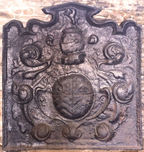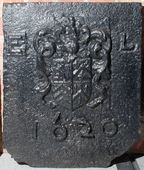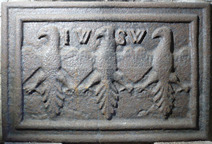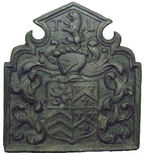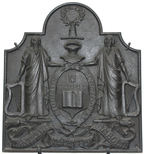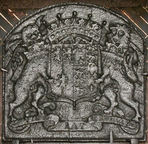-
916
Description: Rectangular, with a detached pediment joined by rebated scrolls; cavetto-moulded edging; circular 'shield' in a cartouche, surmounted by an esquire's helm and lion rampant crest, with mantling behind; initials split by crest; date split in top corners.
Notes: The armorial is of David Prichard (d. 1630) of Llancaiac Fawr Manor; the blazon follows the patriarchal tradition of Welsh heraldry: quarterly, 1st, Sable a lion rampant Argent (for Cydrych ap Gwaithfoed), 2nd, Sable a chevron between three fleurs de lys Argent (for Einion ap Gollwyn), 3rd, Gules three chevrons Argent (for Iestyn ap Gwrgan), and 4th, Sable a chevron between three spear-heads Argent (for Bleddyn ap Maenyrch); the '8' of the date has a flattened top. A copy, from a broken original.
Inscription: D P / 16 28
Arms: Prichard (or ap Richard)
- Decoration tags:
- rectangular with detached pediment (shape)
- cavetto (edging)
- whole carved pattern
- armorial
- text
Manufactured: in 1628 possibly at Dyffryn Furnace in the South Wales area of Wales.
Current location: Llancaiach Fawr Manor, Nelson, Caerphilly, Glamorgan, Wales.
Museum number: GTJ75111 (part of the Caerphilly County Borough Council Museums & Heritage Service museum group)
- Attached to series:
- Personal armorial firebacks
- Welsh armorial firebacks
-
232
Description: Rectangular shape with bottom corners missing; no edging; central shield, helm, crest and mantling of the Lewis family: quarterly 1st, sable a lion rampant argent (Lewis of Y Fan), 2nd, sable a chevron between three fleurs de lys or (Einon ap Collwyn), 3rd gules three chevronels argent(Iestyn ap Gwrgan), 4th, sable a chevron between three spear heads argent embrued gules (Bleddyn ap Maenyrch); initials split by armorial stamp (’E’ over-stamped); date, formed from single numerals, below arms.
Notes: The arms are those of Sir Edward Lewis, of Van, who purchased St Fagans Castle in 1616. The same armorial stamp was used to model the arms on a lead cistern outside the front door of the castle. It is possible that this fireback was cut down from a larger fireback.
Inscription: E L 1620
Arms: Sir Edward Lewis of Van
- Decoration tags:
- rectangular (shape)
- none (edging)
- carved stamps
- individual letters
- individual numbers
- armorial
- text
Manufactured: in 1620 in the South Wales area of Wales.
Current location: National History Museum, St Fagans, Glamorgan, Wales.
Museum number: 48.354/84 (part of the Welsh National History Museum museum group)
- Attached to series:
- Personal armorial firebacks
- Welsh armorial firebacks
- Bristol armorial group
-
1160
Description: Rectangular, with double astragal edging; three eaglets, their wings outspread, side by side; the initials IW and SW, respectively, to left and right of the central eaglet's head.
Notes: The design is based on the arms of Wynn, of Gwydir Castle in the Conwy valley of North Wales, the blazon of which is Vert, three eagles displayed in fess or. The initials relate to Sir John Wynn (1553-1626/7) who, c.1576, married Sydney Gerrard (d.1632), dating the fireback to c.1576-1626. The conjoined wings of the eagles appear to form heart shapes.
Inscription: IW SW
Arms: Wynn of Gwydir
- Decoration tags:
- rectangular (shape)
- astragal (edging)
- whole carved pattern
- individual letters
- heraldic
- text
- animals
Manufactured: in the late-16th to early-17th century in England.
Current location: Gwydir Castle, Trefriw, Conwy, Wales.
- Attached to series:
- Personal firebacks
- Welsh armorial firebacks
-
908
Description: Quasi arched rectangular shape with detached pediment above symmetrical ‘horns’ within arcs; cavetto-moulded edging; shield with helm, crest and mantling; initials split by crest.
Notes: Blazon: quarterly 1st lion rampant (poss. Lewis, descendant of Gwaethfoed); 2nd a chevron between three fleurs de lys (descendant of Einon ap Collwyn); 3rd three chevronels (descendant of Iestyn ap Gwrgan); 4th as 2nd (but possibly different tinctures); crest: a lion rampant; the initials suggest the arms may be of a member of a cadet branch of the Lewis family.
Inscription: T L
Arms: Possibly a member of the Lewis family
- Decoration tags:
- rectangular with detached pediment (shape)
- cavetto (edging)
- whole carved pattern
- armorial
- text
Manufactured: in the late-16th to early-17th century in Wales.
Current location: Ty-r-ash, Brecon Road, Crickhowell, Powys, Wales.
- Attached to series:
- Personal armorial firebacks
- Welsh armorial firebacks
-
737
Description: Armorial within complex ovolo moulded edging on all sides; two plank lines; the achievement is distinguished by the elaborately festooned mantling, the whole resting on a boat-shaped compartment.
Notes: The arms are of an esquire, and the crest - on a chapeau a wyvern, wings elevated and tail nowed, ducally gorged - matches that of the Trevor family. The shield is probably of impaled arms, i.e. those of a husband on the left and wife on the right. The husband's arms include several quarters with lions rampant, which were often a feature of the arms of Welsh families (of which the Trevors were one). The first quarter of the wife's arms is also of a wyvern, but the arms as a whole have not be identified. They have been variously, but incorrectly, attributed to John Trevor who married Elizabeth Morley, née Clarke, to Lord Dacre (a descendant of John Trevor), and to Col. Marcus Trevor, 1st Viscount Dungannon (peers' arms have supporters). The distinctive shape is seen in similar form on several other armorial firebacks from the mid-16th to 17th centuries, suggesting a continuity of pattern making, if not the same pattern maker. Many copies of this fireback exist.
Copies of this fireback are known.
Arms: Trevor
- Decoration tags:
- complex quasi-arched (shape)
- ovolo (edging)
- whole carved pattern
- planklines
- armorial
Manufactured: in the mid- to late-17th century in the Weald area of England.
Current location: Victoria & Albert Museum, Cromwell Road, Kensington & Chelsea, Greater London, England.
Museum number: 142.1892 (part of the Victoria & Albert Museum museum group)
Citation: Gardner, J. S., 1898, 'Iron Casting in the Weald', Archaeologia, 56, 1, pp. 133-164.
- Attached to series:
- Ornate border series
- Personal armorial firebacks
- Welsh armorial firebacks
-
772
Description: Cavetto canted arched rectangle; astragal edging; oval inscription surrounding a central battlemented shield bearing an open book, with a baronet's escutcheon above; above, a helm with a crest of an arm and hand holding a wreath; on each side, a druid supporter holding a harp, each upon a horizontal fillet; below, intertwined bell flowers behind a tripartite motto scroll.
Notes: The motto appears to have been incorrectly spelled; the Conroy baronetcy was created for Sir John Conroy, comptroller of the household of the Duchess of Kent, and much hated by her daughter, Princess (later Queen) Victoria; the 3rd (and last) baronet succeeded to the title in 1869.
Inscription: FIDELITER ET CONSTANTER [Faithfully and constantly] / L'ANTIQIVITE NE PEVX PAS L'ABOLIR [Antiquity cannot abolish it]
Arms: Conroy, baronet, of Llanbrynmair (Sir John Conroy, 3rd baronet, 1845-1900)
- Decoration tags:
- rectangular with canted top corners and round arch (shape)
- astragal (edging)
- whole carved pattern
- armorial
- text
- humans
Manufactured: in the late-19th century in England.
Current location: Victoria & Albert Museum, Cromwell Road, Kensington & Chelsea, Greater London, England.
Museum number: 502.1896 (part of the Victoria & Albert Museum museum group)
- Attached to series:
- Personal armorial firebacks
- Welsh armorial firebacks
-
873
Description: Arched shape; fillet edging; shield, supporters, earl's coronet and motto.
Notes: The arms are those of William Herbert (1626-96), created 1st Earl of Powis in 1674, impaled with those of his wife, Lady Elizabeth Somerset, whom he had married in 1654. He was created Marquess in 1687, so the fireback dates from between 1674 and 1687. The blazon: Party per pale azure and gules three lions rampant argent armed and langued or (Herbert), quarterly 1st and 4th England 2nd and 3rd France Modern (Somerset); Supporters: Dexter: A Panther rampant guardant Argent spotted of various colours fire issuing out of the mouth and ears ducally gorged Azure; Sinister: A Lion rampant Argent ducally gorged Gules; Motto: Ung je serviray (One I will serve).
Inscription: Ung iay serviray
Arms: William Herbert, 1st Earl of Powis
- Decoration tags:
- rounded arched (shape)
- fillet (edging)
- whole carved pattern
- armorial
- text
Manufactured: in the late-17th century .
Current location: Powis Castle, Welshpool, Powys, Wales.
Museum number: 1180869 (part of the National Trust museum group)
Citation: Anon., 1907, 'Armorial iron fire back', Montgomeryshire Collections, 34, p. 212.
- Attached to series:
- Personal armorial firebacks
- Welsh armorial firebacks
